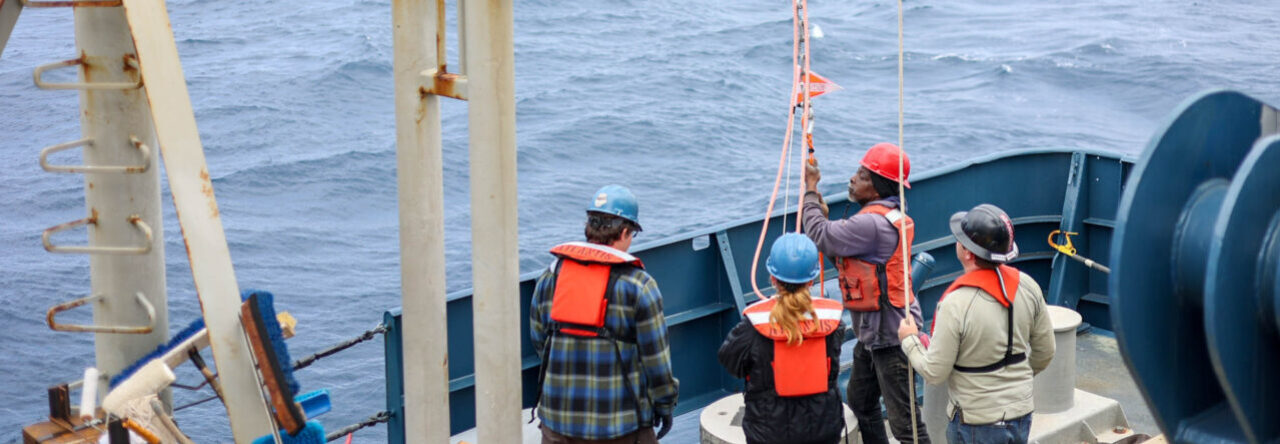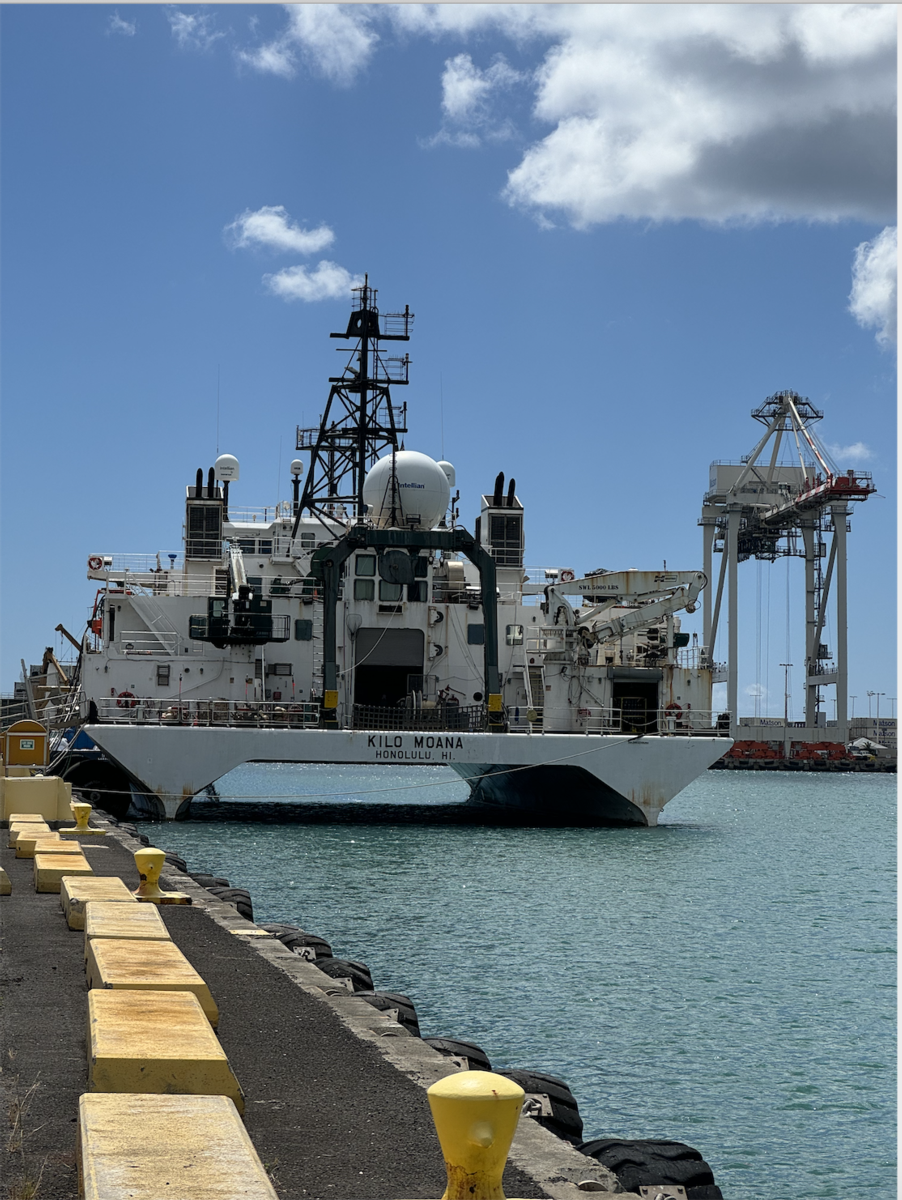
– The Kilo Moana ^
Week #1 with the Hawaiin Oceanographic Time Series (HOTs), expedition #354 proved to be a HOT dive into the wide variety of science that takes place at Station A.L.O.H.A (A Long-Term Oligotrophic Habitat Assessment)! This is an area of the ocean that is about 60 miles north of Oahu that has been routinely sampled since 1988 and is one of the longest oceanographic time series in the world! I am very thankful to been given the opportunity to work with them this week as this short cruise was a really nice training ground for all things CTD and working at sea!
My internship started on October 7th, 2024 with a mini symposium held by Schmidt Sciences and University of Hawaii at Manoa (UH) oceanogrpahy professors and scientists. They presented on the work that they were working on and could potentially collaborate with the larger and developing Ocean Biogeochemistry Virtual Institute (OBVI) that is supported by Schmidt Sciences.
This symposium was really insightful as it introduced to me a lot of the researchers and the science that they do and I might be supporting in the next 10 weeks. The symposium also drove home the impact and importance of the Hawaiian Oceanographic Time Series (HOTS) is to the larger scientific community which gave me a lot of context into the spirit of this mission. Models have demonstrated that it takes about 42 +/- 7 years for climate change signatures to appear in models, but unfortunately many time series don’t get enough funding to reach that length, thus it is essential for long standing scientific endeavors to get the consistent funding and resources they need to continue.
On Wednesday 10/9 I assisted in “Loading Day” and got to meet members of the science party, ship crew and one of my mentors, Dan Fitzgerald . After we loaded boxes onto the ship, I got to observe Dan create a termination on the sensor cable on the CTD, a HOT cruise monthly tradition. The sensor cable is responsible for relaying all the information to the ship in live time, without it can be really difficult to know where you are in the water column, or observe areas of interest that you might want to take a water sample from.
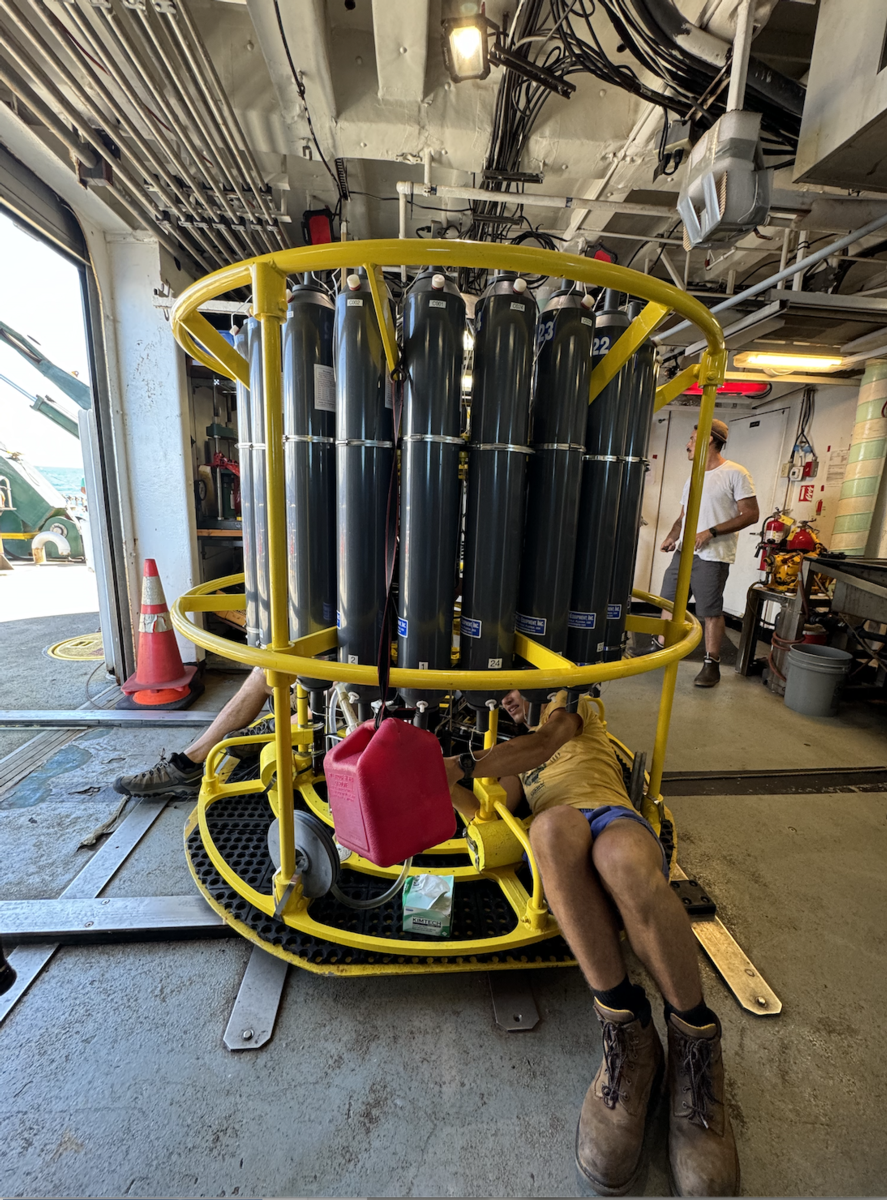
– Hunter Adam and Dan Fitsgerald working on the CTD Rosette
Conducting a new termination (the process of exposing new wire from the cable, splicing, crimping and soldering wires together) is essential to maintaining and repairing any issues caused from things like corrosion and rusting. Conducting new terminations monthly is essential for ensuring signal integrity from the CTD and keeping things running smoothyl given that HOT cruises are short (anywhere from 4-5 days) and ship time is expensive.
Once we set sail the following day, we got to check the integrity of the CTD termination with a test deployment of a set of weights with the bridal attached in Station Kahe (an underway practice station), before deploying it later that evening at Station A.L.O.H.A. During these troubleshooting trials we observe that there was a mechanical issue with one of the oxygen sensors on the CTD so I also observed how Dan swapped out sensors while in the rosette frame, which is quite tricky! Once we left Station Kahe, I went straight to bed to get ready for my 12 hr shift starting at 3am the following morning.
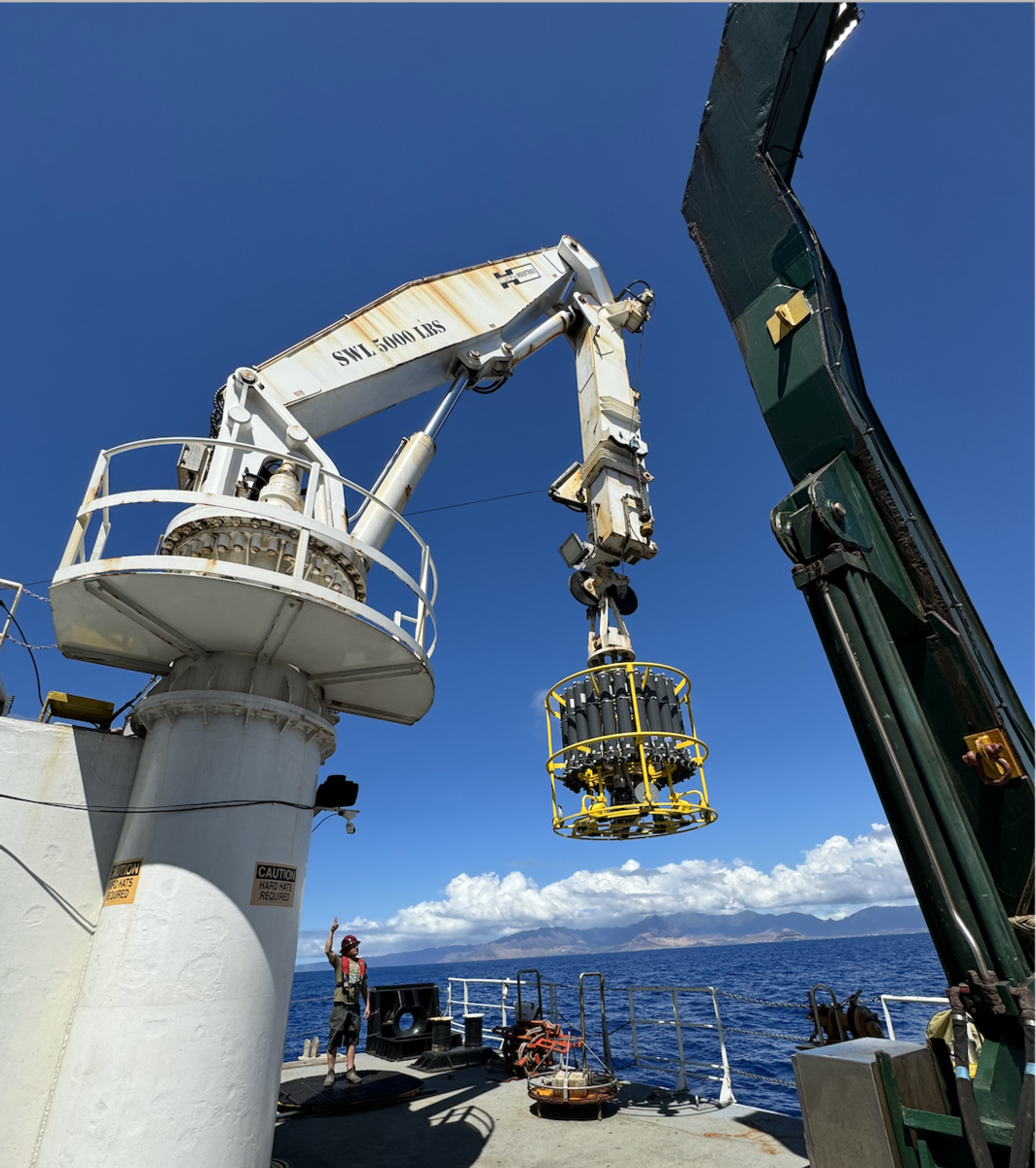
– The CTD Rosette being transported by a Hawbolt Whinch crane overboard in preparation for a cast
In the following days I helped with the deployment of atleast 8 CTD Rosette Cast. I learned how to caulk the bottles and reel it in and out of our CTD shed and general CTD Rosette handling. As well as learned how to communicate with the wrench crew when firing bottles over walkie talkies. Additionally It was really interesting to learn about the wide varieties of cast to be done and how the water is used based on the researchers’ different water needs. For example some scientist are looking at oxygen, or dissolved inorganic carbon (DIC), dissolved organic carbon (DOC), nutrients (Nut), salinity, ATP, particulate carbon (PC), particualte Nitrogen (PN) all of which contribute to the great collection of data that is the Hawaiin Oceanographic time series.

– Cast sheet and schedule posted showing what depth the CTD is being sent to and what depths the bottles will be fired at.

– I got to sit at the CTD console and fire some bottles, this is me holding my cast sheet.
There were a lot of moments that blew my mind this week (like seeing a whale shark in the wild!), but I’d say one of the most impactful things I observed on the cruise was a Gas Array experiment take place from start to finish, a true testiment to the rigors of doing science at sea! By the time my shift started at 3am on 10/12 the CTD had already been brought up and was ready for water sampling. Mattias (an undergrad researcher) and Dan Sandler (HOT Cruise OG) invited me to collect the water in jars and enrich it with N15, a stable isotope that can help track the net production of Nitrogen by Nitrogen fixing plankton. Once those water jugs were filled, they were attached to metal rods and then attached to a line and then deployed on a buoy using the A-frame. These water samples are to sit in the water column at the depth that they were collected for 24 hours before being retrieved. The retrieval process however, is quite dramatic given that it’s done in the pitch of dark (10/13 at 5:30 am) and the Kilo Moana is a double hulled boat that could potentially “run over” buoys or have it get caught in the propellers if the navigation team and scientific crew are not careful. I watched in suspense as we approached the buoy the samples are attached to and watched the bouy slowly dogde the middle of the R/V Kilo Moana and float past the side of the hull, phew!!! Mattias and Hunter (fellow UNOLS-MATE intern) bravely threw grappling hooks overboard to get some control on the buoy, and swing it to the stern of the boat, where the Ocean Technology Group (OTG) and deck crew were ready to latch a stick with a hook to the line and start wringing in the buoy on the back deck using the boat’s A-frame. Once the bouy was on the ship we all breath a sigh a relief, we had succesfully retrieve our samples without any issues!
It’s astonishing how well HOT Cruise #354 went, the scientific party and crew have this expedition down to a T! HOT Cruise #354 proved to be a wonderful primer to the type of work we’ll be doing on the South Pacific Cruise I’ll be embarking on next week. We expect to be doing a lot of CTD Rosette Cast, Gas Arrays, Primary Productivity arrays and more so these skills will most definitly come in handy!
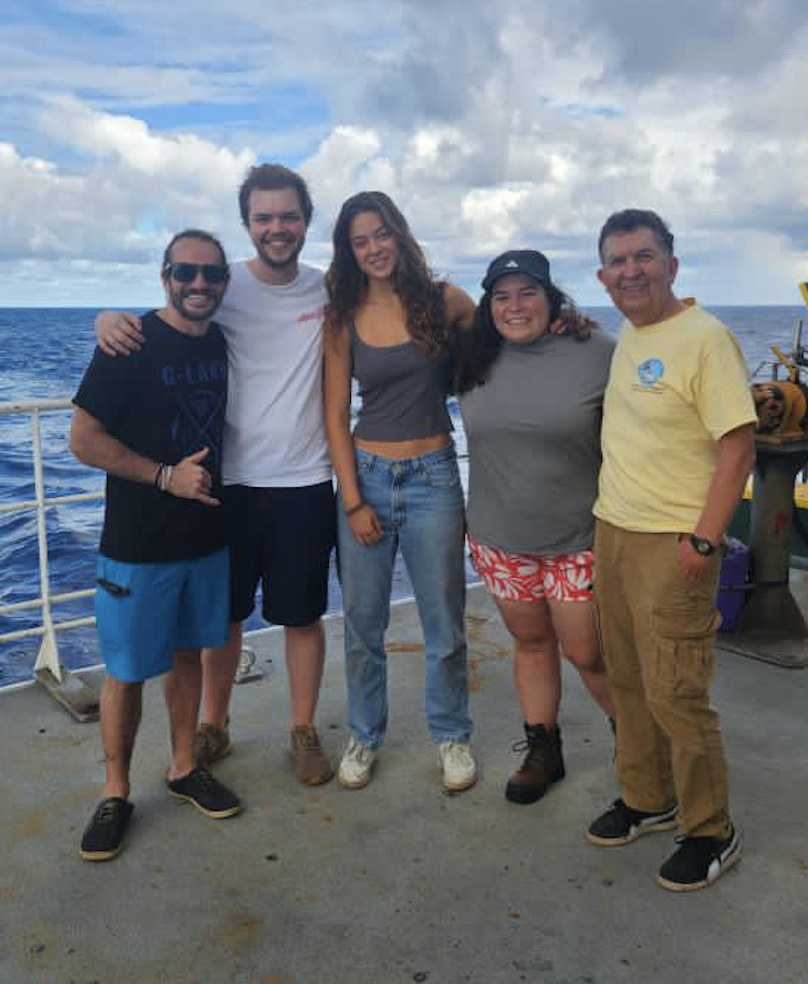
– Fellow HOT Cruise #354 volunteers 🙂
Cheers,
Briana Prado
* hehe, here is said whale shark, taken via go-pro by one of the AB’s on aboard!


